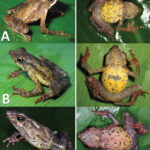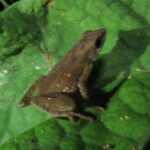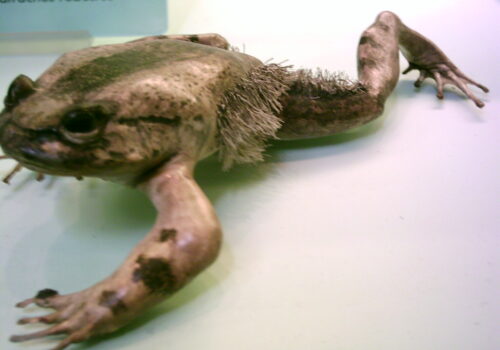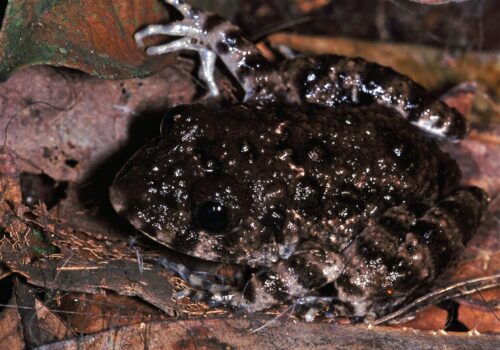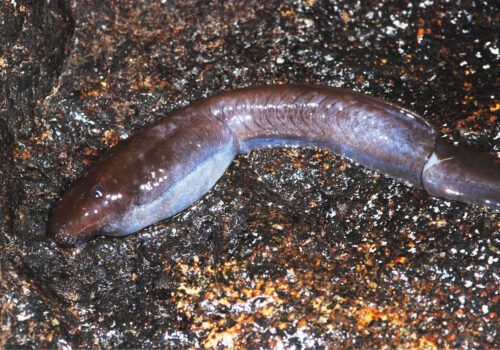- Leptopelis lebeaui: Unveiling the Secrets of a Little-Known Rainforest Frog
- Taxonomy and Classification: A Frog Among Giants
- Natural Habitat: Living Amid Emerald Shadows
- Physical Characteristics: A Tiny Jewel of Adaptation
- Behavior and Life Cycle: An Intricate Ballet of Survival
- Ecological Role: Guardians of Biodiversity
- Threats and Conservation Status: Facing an Uncertain Future
- Cultural and Scientific Significance: Tiny Frogs, Big Discoveries
- Conclusion: Safeguarding a Hidden Treasure
Leptopelis lebeaui: Unveiling the Secrets of a Little-Known Rainforest Frog#
Beneath the dense rainforest canopies of Central Africa, in the whispers of leaves dripping from an evening rain, lies a hidden world teeming with fascinating creatures. Among them, remarkably elusive and delightfully charismatic, thrives the tiny frog known as Leptopelis lebeaui. Often overlooked amid larger, more glamorous creatures of Africa’s forests, this intriguing amphibian reveals astonishing stories of survival, adaptation, and ecological importance.
Known scientifically as Leptopelis lebeaui, this species belongs to the Arthroleptidae family, a vibrant and diverse group of frogs renowned for their unique behavioral traits, melodious night choruses, and critically important roles within their ecosystems. Yet, despite their undeniable charm and ecological significance, these frogs remain lesser-known outside specialized circles, their stories whispered only among dedicated herpetologists and rainforest explorers.
In this immersive journey into the life of Leptopelis lebeaui, we venture deep into its native habitats, explore its intricate life cycles, reveal the mysteries behind its fascinating behavior, and discuss the threats and conservation actions that safeguard its place in the rich tapestry of African biodiversity.
Taxonomy and Classification: A Frog Among Giants#
To appreciate the subtle charm and ecological role of Leptopelis lebeaui, we must first understand its position within the vast amphibian tree of life. Belonging to the family Arthroleptidae—a family composed primarily of African frogs—Leptopelis lebeaui takes its place amid nearly sixty recognized species within the Leptopelis genus. This genus is particularly notable for remarkable vocal abilities and arboreal tendencies, qualities Leptopelis lebeaui shares proudly.
Often called the “tree frogs of Africa,” species within Leptopelis are distinguished by their arboreal habits, melodious calls, and adaptive physical features for life amid foliage. Leptopelis lebeaui was originally described and named in honor of Charles Lebeau, reflecting the longstanding tradition in biology of acknowledging key figures in scientific exploration and study.
Natural Habitat: Living Amid Emerald Shadows#
The beauty of Leptopelis lebeaui extends beyond the creature itself, woven intricately into the lush biome it calls home. This frog is typically found inhabiting the rainforests within the Democratic Republic of Congo and nearby Central African regions, preferring the humid, leaf-shrouded worlds beneath towering hardwoods and lush vegetation.
Under the rainforest canopy, humidity is constantly high, allowing mosses, lichens, ferns, and fungi to thrive. Within these emerald worlds, Leptopelis lebeaui finds ideal conditions: ample moisture to support its sensitive skin, abundant insect prey for nourishment, and strategically safe spaces to hide from predators. They prefer areas close to freshwater bodies—small streams, ponds, and marshes are optimal breeding grounds for their delicate eggs and larvae.
Embracing the Forest Canopy#
Interestingly, while Leptopelis lebeaui spends much of its adult life closer to forest floors among vegetation, it’s also adept at climbing plants and low-lying bushes to escape predation and communicate with other individuals. Its arboreal skills may be less pronounced than some Leptopelis cousins, but climbing adaptations—long, strong legs with extended toe pads—give it the grace and agility to navigate swiftly through intricate lower vegetation.
Physical Characteristics: A Tiny Jewel of Adaptation#
Measuring only around 3-5 centimeters from snout to vent, Leptopelis lebeaui is modest in size but high in beauty and biological specialization. Its coloration varies beautifully between subtle greens, pale yellows, earthy browns, and occasional darker blotching. Such coloration provides vital camouflage, enabling it to essentially vanish within the mottled rainforest understory.
Its large, expressive eyes mounted prominently on its head are adapted for enhanced nocturnal vision, crucial in a world permeated by everlasting dimness beneath dense canopies. Their horizontal elliptical pupils dilate widely at night, gathering even the faintest traces of moonlight filtering through the leaves. Their limbs, slender yet powerful, sport sticky toe pads, vital for secure footing on moist foliage and branches.
These adaptations not only define their appearance but ensure their survival, equipping Leptopelis lebeaui to skillfully navigate the myriad challenges of rainforest life.
Behavior and Life Cycle: An Intricate Ballet of Survival#
Each evening, when the forested worlds slowly plunge into twilight, Leptopelis lebeaui awakens from daytime hiding places under moist logs, leaves, or shaded crevices. They venture forth to hunt, employing ambush tactics—remaining motionless for long periods before darting toward unsuspecting insects and arthropods with precise, lightning-fast leaps.
A Symphony in the Dark: Vocal Communication#
The secrets of Leptopelis lebeaui truly flourish after dark, though their nighttime chorus is subtle when compared to louder relatives. Male frogs take advantage of moist nights to emit soft, resonant calls designed to attract mates and assert territorial claims. Each male’s characteristic vocalization—short bursts of smooth, whistling sounds—helps females identify strong, suitable mates, thus promoting propagation and genetic vitality.
Metamorphic Marvel: From Egg to Adult#
Breeding typically occurs adjacent to adequately wet habitats where females deposit clusters of jelly-encased eggs. These eggs hatch into robust tadpoles that inhabit small ponds and streams, meticulously occupying niches of shallow, plant-rich waters abundant in algae and other nutrients critical to development.
Gradually transforming through metamorphosis, tadpoles develop legs and lungs and absorb tails until finally venturing ashore as tiny replicas of adult frogs. Through this delicate life cycle, Leptopelis lebeaui bridges aquatic and terrestrial worlds seamlessly.
Ecological Role: Guardians of Biodiversity#
While diminutive in size, Leptopelis lebeaui plays outsized roles within the rainforest ecosystem, subtly balancing predator-prey dynamics. They serve as important insect regulators, helping maintain healthy populations of insect species and benefiting the larger web of rainforest biodiversity.
Equally valuable as prey for larger predators—including snakes, birds, and occasional mammalian hunters—they indirectly sustain higher rainforest fauna, forming an intrinsic link within bustling, multifaceted food webs. Moreover, amphibians like Leptopelis lebeaui act as bio-indicator species, responding quickly to ecological disruptions and providing warnings ecosystem-wide.
Threats and Conservation Status: Facing an Uncertain Future#
Sadly, like so many rainforest species, Leptopelis lebeaui finds itself increasingly vulnerable. Habitat loss due to deforestation, agriculture, and logging is the gravest threat. Climate change exacerbates habitat instability and may disrupt regular rainfall patterns crucial for survival. Pollution, invasive species, and diseases such as chytridiomycosis further compound vulnerability.
Although detailed population surveys remain limited, these cumulative threats yield conservation concern. The International Union for Conservation of Nature currently classifies Leptopelis lebeaui as “Least Concern” due to its wide range. However, continuous monitoring and habitat protection remain crucial to safeguarding their ecological well-being against mounting pressures.
Cultural and Scientific Significance: Tiny Frogs, Big Discoveries#
In a world where discovery and delight intertwine, amphibians like Leptopelis lebeaui offer untapped scientific treasures. They continue to yield insight into ecological health and inspire biological research. While rarely central to traditional cultural narratives, rainforest amphibians symbolize remarkable biodiversity and nature’s delicate interconnectedness, fostering conservation appreciation among national and global communities.
Conclusion: Safeguarding a Hidden Treasure#
Within Central Africa’s rainforest canopy, woven subtly into the very fabric of biodiversity, Leptopelis lebeaui remains a shining example of nature’s intricate balance. This graceful frog, humble in appearance yet momentous in ecological importance, reminds us that conserving even the smallest creatures protects the integrity and magnificence of the world’s most treasured habitats.
Let us listen carefully to the gentle choruses hidden among rainforest shadows, mindful that every call represents resilience, adaptation, and life waiting to be discovered and protected. Embrace curiosity, foster compassion, and join global efforts aimed at preserving Leptopelis lebeaui and other little-known heroes of biodiversity.


